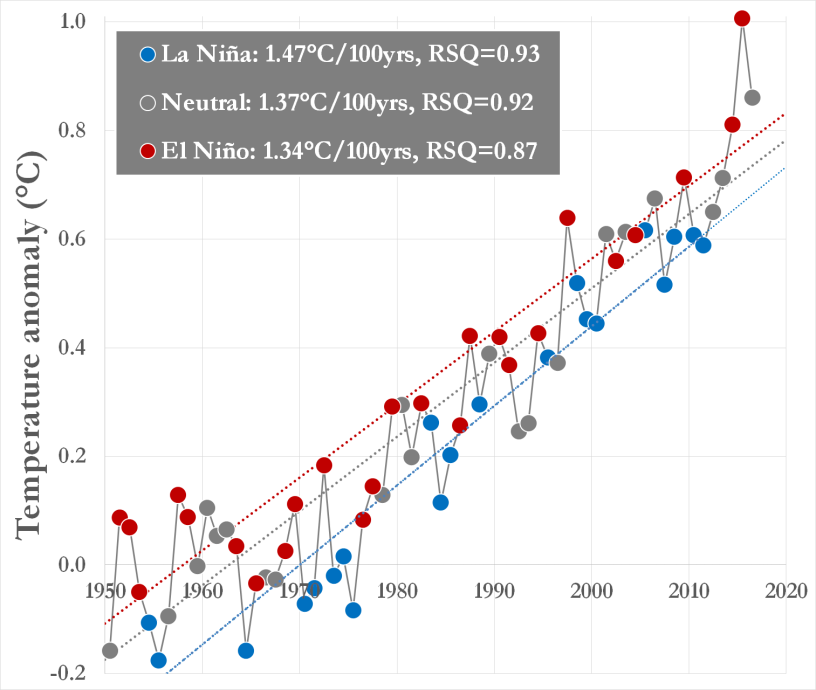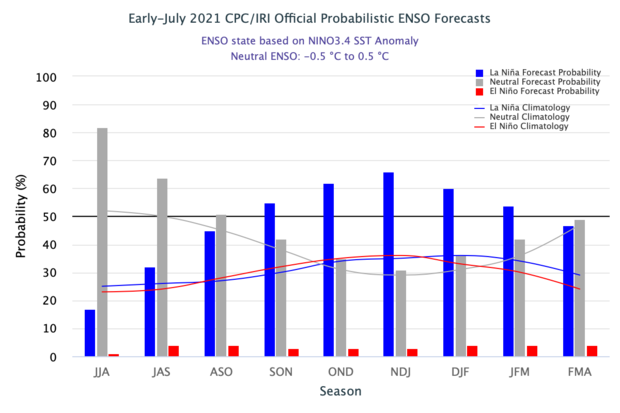La Nina Years Graph
Other seasons have impacts toobut do not necessarily match the winter seasons. Only 2 years recorded above normal snowfall 1955-1956 was 37 inches above normal and.

Poor Design Example 2 Graphing Design Bar Chart
Otherwise it is considered neutral.

La nina years graph. ENSO-neutral year normal and a LA Nina year colder water. Notice the red blocks near us for a b but then those areas lift to our north by c and d. The annual M-VHI values during the two La Niña dominant cycles pink graph background turn out to be higher than the average.
The great Dust Bowl drought of the 1930s is thought to have been caused by a decade of La Niña-like conditions and was likely responsible in part for the severe drought in the American Midwest in 1988. The 1988-89 La Niña believed to be one of the most severe in history has been estimated to cost 40 billion in damages in North America. Episodes of El Niño and La Niña typically last nine to 12 months but can sometimes last for years.
ENSO Alert System Status. Years are determined from Dec-Jan-Feb DJF values of the PSL MEIext index. El Niño La Niña and Rising Global Temperature.
El Niño and La Niña can both have global impacts on weather wildfires ecosystems and economies. 74 rows The Oceanic Ni ñ o Index ONI has become the de-facto standard that NOAA uses for identifying El Ni ñ o warm and La Ni ña cool events in the tropical Pacific. In fact of the twelve first-year La Nina events eight were followed by La Nina the next winter two by neutral and two by El Nino.
But it is not unusual to have two La Nina events follow each other. El NiñoSouthern Oscillation ENSO Diagnostic Discussion issued jointly by the Climate Prediction CenterNCEPNWS and the International Research Institute for Climate and Society. It is the running 3-month mean SST anomaly for the Ni ñ o 34 region ie 5 o N-5 o S 120 o -170 o W.
El Niño and La Niña are two opposing climate patterns that break these normal conditions. Red for El Niño years and blue for La Niña years. Ranked La Niña Events by 3-Month Season.
For the official history of El Niño and La Niña events see. La Nina events normally last about a year but climate models suggest this years pattern will be short-lived persisting until the late southern hemisphere summer or early autumn 2022 Watkins said. A January-February-March b February-March-April c March-April-May d April-May-June.
The ONI only tracks the temperatures in the Niño34 region but during strong events the entire central and eastern tropical Pacific will generally become warmer or cooler than average. ENSOevents are most clearly defined in northern winter DJF both in terms of impactsand robustness with regard to the ENSO index used. Such an event is called a second-year La Nina.
If the bars on the graph are approaching or exceeding the blue dashed line there is an increased risk of La Niña. Sea surface temperature across the tropical Pacific Ocean in December 1997 top during a strong El Niño and in December 1988 bottom during a strong La Niña. In the 10 total moderate to strong La Niña events Niño 34 Index of -10 or lower only 1 year recorded above normal precipitation 1998-1999 was 1060 inches above normal.
The graphic above shows the difference between an. The graphs are based on the ensemble mean for the most recent model run. And in the 5th highest 1998-99 3 of the 4 areas were over 140.
The world has been rapidly warming at a rate of 14C per 100 years since 1950 according to NOAA data. These graphs show the average forecast value of NINO34 for each international model surveyed for the selected calendar month. La Niña years exaggerate the normal pattern.
Warm red and cold blue periods based on a threshold of - 05 o C for the Oceanic Niño Index ONI 3 month running mean of ERSSTv5 SST anomalies in the Niño 34 region 5 o N-5 o S 120 o-170 o W based on centered 30-year base periods updated every 5 years. The winds blow harder than usual causing warm water to pool around Asia while surface temperatures across the rest of the Pacific fall. Rank DJF JFM FMA MAM AMJ MJJ JJA JAS ASO SON OND NDJ.
Scientists call these phenomena the El Niño-Southern Oscillation ENSO cycle. La Niña Advisory Synopsis. During two El Niño dominant cycles blue graph background in most of the years the M-VHI values are below average.
El NiñoLa Niña labels are based on the December-February anomaly of the Oceanic Niño Index. The below table shows the monthly value of the ENSO Outlook for historical comparisons. The ENSO Outlook status is updated each fortnight.
La Niña is likely 80 chance from September-November 2021 to December-February 2021-22 with a 60 chance of continuing through February-April 2022. The warmest and coldest years of each decade are topped with circles. To classify a historical El Niño event the 3-month average Nino34 value must be above 065C for 5 or more consecutive months.
This is exactly what we are seeing this year with new cooling emerging in the ENSO region. In the 2 highest years 1973-74 and 1970-71 3 of the 4 selected areas were over 130 of normal snowfall. The chart illustrates this warming for El Niño years red La Niña years blue and ENSO-neutral years grey.
The graph shows the probability of La Niña blue bars El Niño red bars and non-ENSO or neutral conditions gray. It is broken down by three-month intervals. The ENSO Outlook graph and table are not an official time-line of ENSO events.
Every La Nina has different impacts as it is not the. For La Niña events the threshold is -065C. La Niña is likely to continue through the Northern Hemisphere winter 2021-22 90 chance.
ENSO events with a peak value above 15C El Niño or below -15C La Niña are considered strong. The below graph shows the fortnightly values dating back to January 1980. Results are quite consistent for these 4 areas in the strong La Nina seasons.
1 clearly shows the impacts of the El Niño and La Niña dominant cycles. All 4 areas are at least average in the top 8 La Nina years except for Sunshine at 94 in 1974-75. Events are defined as 5 consecutive overlapping 3-month periods at or above the.
This graph shows annual average surface temperatures gray bars grouped by decade from 1950 to 2017. IRI ENSO Forecast CPCIRI ENSO Update Published.

July 2021 Enso Update La Nina Watch Noaa Climate Gov

The Oceanic Nino Index Oni With El Nino And La Nina Strength Years Download Scientific Diagram
Posting Komentar untuk "La Nina Years Graph"